The Content Marketing Conference 2022 has reached its end, completing three days of events filled with great talks to help content marketers keep up to date with the main trends in the field. If you missed the main highlights of the first day, make sure to read it here before moving on to these following days — and prepare for some outstanding insights.
On the second day, the thematic sessions were aimed at optimization and distribution of content, two of the main content marketing pillars.
And closing the conference with a golden key on the last day, the keynotes covered performance and… comedy!
Curious about the best insights from the final days of #CMC22? Let’s check what was presented in the live keynotes and what content was in each session.
“Regardless of the industry, you’re in the experience business” – Brittany Hodak (Keynote Speaker & Author of Creating Superfans)
We’re living in an Experience Economy. Customer experience, or CX, is the new battlefield for winning over — and keeping — customers. According to a recent study by Gartner presented by Brittany Hodak (Keynote Speaker & Author of Creating Superfans), CX drives over two-thirds of customer loyalty. That’s more than brand and price combined.
To Brittany, customer apathy is one of the biggest threats to business today. Whether they realize it or not, every member of your organization is a member of the Experience Department. Everyone has the power to create superfans: loyal, enthusiastic customer advocates.
She shared her memorable, five-part framework that aligns audience members around the actionable steps businesses must take to turn customers into superfans. Go from commodity provider to category of one in the minds of your prospects and customers. She said, “Stories accelerate the path to connection.”
Start with your story
A story is important to get people to pay attention to every matter. Super fans are created at the intersection of your story and customers’ story. It’s about the way you make customers feel. Stories are the key to creating a brand that customers know and trust. Every touchpoint is an opportunity to tell your brand’s story. It’s important to know what makes your brand special.
Understand your customer’s story
People don’t care how much you know until they know how much you care (quote by Theodore Roosevelt). Know your customers and let them know how much you care. Use empathy and authority. Sometimes we overthink things, brands need to take time to listen to customers and understand their stories.
Personalize
“Treat others the way they want to be treated, not the way you want to be treated.” Show your brand cares about customers. Grammarly is a great example of a brand that uses personalization to deliver what customers want (through AI). Try to use personalization in all products or funnel stages, to connect to your customers.
Exceed Expectations
Every interaction makes customers feel: Negative, Neutral or Positive. Brand employees need to create net positive outcomes to make customers feel better, and take people from a negative experience to a neutral or positive experience. People don’t forget memorable experiences with brands.
Repeat
It’s not magic. Brands need to repeat and continue to do things that matter. In every phone call, every email, and in all interaction with customers. “Repetition makes reputation and reputation makes customers” (quote by Elizabeth Arden).
“Content still matters, just deploy to a more efficient channel” – Larry Kim
Inbound as the new outbound. That’s what Larry Kim (founder and CEO of MobileMonkey) suggested in his keynote speech.
We mostly do content marketing to get leads and close sales, using the channels we typically engage on, such as blogging & SEO, social media, email marketing, and digital ads.
The digital ads are very competitive and SEO blogging takes a lot of effort to rank content in the first spot, so it’s a very challenging path and it’s been even harder day after day.
After all the effort to run these inbound strategies, Larry doesn’t think it’s still valuable anymore to stick with just them alone, because it takes a lot of time and many fronts to work on. In the end, the entire inbound strategy is usually created under a customer profile (or a persona), so it’s not something individually created to please and attract the right customer.
This lack of individualism is what makes Larry suggest using outbound as the new inbound – or, at least, add some outbound to your channel mix!
99.99% of companies are using a mixture of social media, YouTube, social ads and content marketing. “It’s a lot of work and you have to pray to the algorithm gods to help you get leads and sales.”
“On the other side of it, you might have target companies where you can just call, email or text the prospect directly.”
When you start doing outbounding you can email people to create connections. It’s really easy to scale initially, but he warned that then when people get overscaled it can be harmful to your strategy.
“A business which stands for nothing will fall for anything” – Kuda Biza (Speaker, Author, and Change Agent)
We already talked a lot about brand purpose and how, if you apply it in your marketing strategies the right way (that goes beyond marketing) that also means more growth for your company.
That’s exactly what the serial Entrepreneur, author, speaker, and philanthropist Kuda Biza explained in his keynote speech.
According to him, when customers have a solid emotional bond with the brand, it means more sales. With more sales, more profit. With more profit, more impact. It’s a vicious cycle of growth and meaningful impact.
And how does one do that? By being purpose-driven.
Some big companies have already started to see the benefits of being a purpose-driven company. Among than, P&G
When your company is truly purpose-driven, you’re not only able to attract more clients, but also attract and retain talents (as we already talked about deeply in this article).
But, for all that to work, you want to make sure that your purpose is truly authentic and allied with your brand and the community you want to achieve.
And how do you decide what cause to focus on? For Biza, the key mindset is to align the cause with your business. If you’re having trouble with that, one good idea is to bring your customers into the fold and co-create with them, and have a sense of belonging and impact that you’re going to focus on.
Last but not least, some entrepreneurs might think that focusing on purpose can distract the company from being profitable. Well, for Biza, it’s quite the opposite. In his words, “purpose adds fuel to your goal.”
“The best copywriter today has more empathy for the audience” – Ann Handley (Wall Street Journal bestselling author)
Content marketing and storytelling offer a vast opportunity for all businesses. But too many of us aren’t embracing the opportunity. Our own marketing seems puny and underdeveloped, when it should be Superhero-level strong and ripped.
So the question is: how do we become superheroes within our companies or for our clients? How do we inspire our teams to create more robust, effective marketing? How do we improve the quality of what we are producing? (And how do you define “quality,” anyway?)
Byron White interviewed the Queen of Content Ann Handley, best-seller author of Everybody Writes: Your New and Improved Go-To Guide to Creating Ridiculously Good Content.
During the talk, Ann shared her process while writing the book, and how it was vital for her to listen to the public and research to understand how to create good content.
Here are some of the best insights from this talk:
AI-Writing
Do AI-Writing tools help with content production? Well, it might. But Ann believes that these tools will not affect creative writers.
To use these tools, we need to know the basics of writing good content, but a bot will never be able to replicate someone’s voice. So, we need to embrace our own voices to be stronger communicators.
Newsletters
She also highlighted newsletters as the most original and valuable content format currently. According to her, when it’s done right, brands can build a relationship with their public — speaking of that, have you checked our interactive newsletter for marketers and leaders yet? Here it is.
Content hacks
Ann also shared some good tips when it comes to content production:
- The biggest missed opportunity in content marketing is playing it too safe.
- Tell bolder (and braver!) stories, using stronger, more ripped writing and a unique point of view.
- Create “best of breed” content to attract the people you want (and repel the ones you don’t).
- Understand when to be a little outrageous (and when to dial it back).
- Be fun instead of being restricted to grammar
Last but not least, the key to writing more engaging content: spend a lot of time on the beginning, understanding who it is for, what we are doing, why it matters and why now.
“The words that we use can change the way people think and feel about what we’re saying” – Nancy Harhut
Closing the keynote series on the third day of the conference, Nancy Harhut (Chief Creative Officer at HBT Marketing) talked about behavioral science secrets and hacks for content creators to crush it.
What does that mean? It means that you want to create content that is brain-friendly, that goes directly to our behavior and automatic response. But how? Well, Nancy shared some good practical tips (and lots of examples on how to implement it):
It’s not about how we think, but how we feel
Behavior science found that emotions drive our decisions. We make decisions based on emotion, and justify with rational arguments (even the simple ones, like what to eat for lunch).
Creating content and copywriting that relies more on how what you want to show makes your reader feel — and less on your benefits and solutions — can be a powerful writing tip. Here’s an example of a B2B company, Slack:
They are not talking about their efficiency, they are talking about how their product will make people in the company feel.
It’s important to know that not all feelings are equal in our brain: people are afraid to lose. We feel the loss more powerfully and try harder to avoid it — so it might be good to place a little loss aversion in your content.
Here’s another example:
Our choices are less rational and more reactional
People think they know why they are making decisions, but there are several other factors influencing that decision that people don’t know — and you, as a marketer, can take a lot of advantage of that.
According to Nancy, behavioral science says that having an option makes people more likely to choose. It gives us a feeling of expertise and some kind of control.
Here’s an example: a survey in New York City showed that when traffic lights presented a button for a person to press to request the light to open, people were more patient and likely to wait than if they simply had to wait (with no button to press).
The wait time was the same. But the fact that they pressed the button gave people a sense of control over the situation, and it made them less irritated by the wait.
Remember: choices make people feel in charge, but too many can make people feel lost. Be careful with that.
We rely on auditory cues
Nancy also shared other practical tips to take advantage of the way we make decisions into our marketing strategies. For example:
Reason why — when we use ‘because’ justifying what we want to say, people are more likely to hear and believe our reasons (and act on them).
Input bias — the more time and effort we put into something, the more people tend to believe. For example, if a food company says “after a decade of research, we developed the perfect french fries.” People are more likely to believe that these fries must be awesome, than if the company had just said “we developed the perfect french fries.”
Anchoring — We’re always influenced by the first number we see in a conversation. Listing the higher price first can make people more likely to buy at a cheaper price.
Optimization and Distribution Sessions
Following the same structure from the first day, participants could attend many recorded sessions from recognized digital marketers. This time, the content was aimed at two other essential content marketing pillars: optimization and distribution.
While the first day sessions covered the foundations of a content strategy, the second day sessions focused on how to make the most out of your content.
The Optimization Sessions were full of hands-on tips to make your content stand out and really engage your audience. Creating content is not enough. You need to think strategically how it fits in your whole strategy and how it can perform better.
The topics in this session were:
- Effective Delegation: The Missing Ingredient for Most eCommerce/SEO Business Owners
- De-Risk Domain Authority: How to Increase Content Efficiency
- 3 Unique Ways to Leverage Keyword Research
- Overcoming Strategic Challenges in Content Marketing
- Do This, Not That: Ignite Your Email Marketing
- New “Helpful Content” Ranking Strategy: Use Social Behavior and Audience Interest
- 10 Positioning Strategies to Make your Product/Service 10x More Valuable
In the Distribution Sessions, it was time to learn how to reach more people with the content you create. If your content isn’t seen, it doesn’t bring much value, right? So, learning how to distribute your content is a must for your strategy.
The topics were:
- An Inside Look into Profitable YouTube Ad Campaigns and the Strategies that Make
- LinkedIn Ads: The Secrets to Lower Cost & Higher Performance
- Plan & Record Video Like A Pro From Anywhere
- A Guide to Marketing to Gen Z:
- How to Reverse Engineer Your Competitor’s Social Media Content Strategy
- How To Scale Marketing While Revenue Grows 5x in One Year
- TikToks and Shorts and Explainers, Oh My!
- 5 Savvy Ways to Leverage Web 3 with Your Marketing
Did you miss all this content and don’t want to be left behind? You still have time! Just access this link to get your FREE 3-day ticket! All content (keynotes and sessions) will be available for all users next Monday and Tuesday (11/14 and 11/15).








